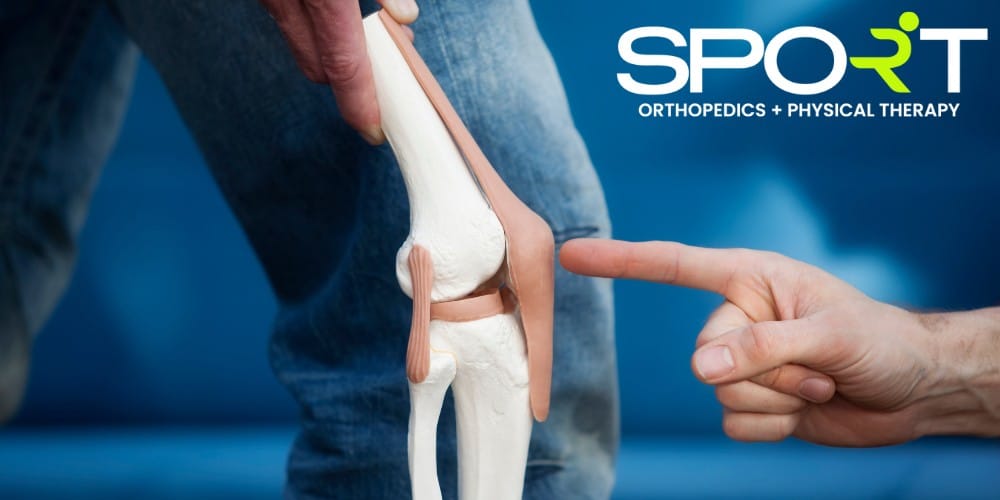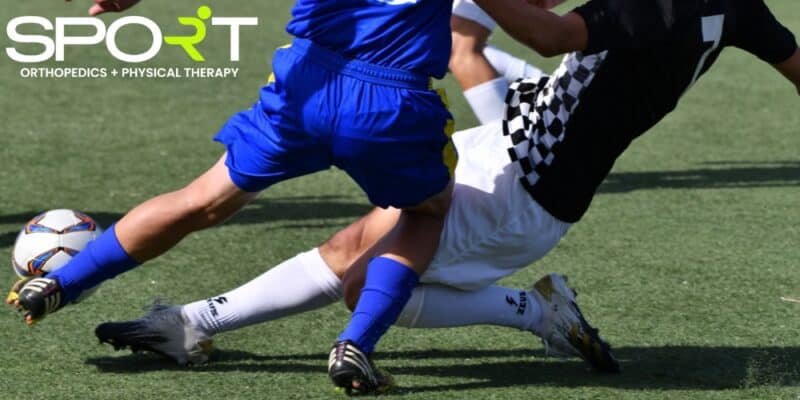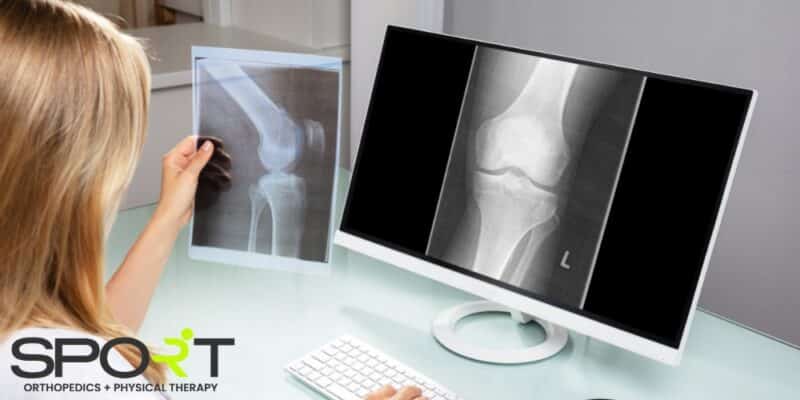Patellar Dislocation Treatment in Dallas & Frisco
Treatment for Dislocated Patella, Patellar Subluxation, Dislocated Kneecap
Patellar Dislocation Diagnosis and Treatment in Dallas & Frisco, TX
Suffering from patellar dislocation can really put a damper on your daily life. Severe pain, instability, and sometimes an inability to walk can all accompany a patellar dislocation. Whether you’re an athlete, a hobbyist, or otherwise, dislocating your knee can be a painful inconvenience. Luckily, our orthopedic specialists have a wide range of solutions for this pain, both surgical and nonsurgical.
At SPORT Orthopedics + Physical Therapy, we aim to offer only the best in orthopedic care for our patients. We will evaluate your symptoms, identify the source of your pain, and develop a personalized treatment plan that works for you. If you need quality treatment from one of the best orthopedic surgeons in Dallas, we’re here for you. To schedule an appointment with one of our providers, please call our office at 469-200-2832 today.

What Is Patellar Dislocation?
Patellar dislocations occur when the knee cap (patella) dislocates sideways out of the groove where it sits in the knee joint. A kneecap dislocation can occur for a number of reasons, including blunt force, collisions, falls, or taking a bad step. This injury is usually painful and often makes walking difficult or even impossible. However, patellar dislocations are fairly easy to treat and can even correct themselves in some cases.
Acute patellar dislocation is the specific term used to describe patellar dislocations that happen due to force or trauma. In rare cases, the structure of the knee can force the patella out of place. This condition is known as congenital patella dislocation. The patella basically forms outside of where it should sit in the trochlear groove, and it can’t be popped back into place. These cases often require corrective surgery.
Patella Dislocation vs Knee Dislocation
A dislocated kneecap differs from a knee dislocation in that the affected bones are different. A knee joint dislocation involves the thigh and shin bones, while a patellar dislocation involves the kneecap, or patella. Other notable forms of patellar dislocation include primary traumatic patellar dislocation, acute patella dislocation, and trochlear dysplasia.
Patella Dislocation vs Patella Subluxation
Patellar subluxation is simply another term for a dislocated kneecap. Some people experience chronic patellar instability, which can lead to recurring kneecap dislocation. For most people, it is rare to completely dislocate the knee, but patellar dislocation is slightly more common. This is due to the mobility of the kneecap itself. In fact, if you were to push your patella from side to side, you could see and feel it move slightly out of place.
What Causes a Dislocated Patella?

As we mentioned previously, a dislocated kneecap can occur from either the abnormal structure of the knee, or from a sudden, forceful blow to the knee. It can also happen when someone suddenly changes directions and turns their knee too sharply. Certain sports, such as football and soccer, as well as dancing, can increase one’s risk of these common knee injuries.
Can You Walk with a Dislocated Patella?
In most cases, no. With a dislocated kneecap or knee, it is very likely that your knee will lock into place, and you will be unable to bend it. If you try to bend it, the knee will likely catch and pop, causing pain. Bearing weight will cause pain, and the knee may buckle underneath you. If you only have a dislocated kneecap, you may still be able to walk. Even if you pop the dislocated patella back into place, your knee joint may still be swollen and painful to move.
How Painful Is a Dislocated Patella?
Depending on how far out of place the patella dislocates, the pain can be very severe, even debilitating. The level of pain also heavily depends on how much damage the surrounding tissue suffers. Regardless, a dislocated kneecap or knee will almost always be accompanied by pain while you bend it or bear weight on it.
How to Diagnose a Patellar Dislocation

So, how is a dislocated kneecap diagnosed? When you come into our office for your appointment, we will begin by taking your medical history. Then, we will perform a physical exam of the affected knee. In some cases, the knee will be very obviously out of its normal position, which will signal a dislocation. Kneecap dislocation, however, is not always obvious. In order to confirm the diagnosis of a dislocated patella or knee, we will take a knee X-ray. If the knee is too swollen for an X-ray, or if we suspect damage to the surrounding tissues, we may also order an MRI of the area.
An MRI may be necessary if we suspect damage to the surrounding soft tissues and ligaments. Some of the structures that we will check for injury include the following.
- Medial patellofemoral ligament
- Lateral femoral condyle
- Patellar tendon
- Quadriceps tendon
- Tibial tubercle
- Vastus medialis muscle
- Medial retinaculum
- Vastus lateralis muscle
Dislocated Patella Symptoms
Symptoms of a dislocated knee or kneecap are easy to identify, and they include the following.
- Knee feels unstable
- Sudden swelling of the knee
- Inability to bend or straighten the knee
- The kneecap (patella) slides too much from side to side
- Knee appears to be deformed
- Tenderness and pain
- Kneecap slides to the outside of the knee
If you suffer from recurrent dislocation, your pain and disability from the dislocation may lessen with repeated dislocations. However, this does not mean you should avoid seeking treatment. Each time a dislocation occurs, the leg muscles and other surrounding tissues suffer damage. This means that dislocations result in more than just an unstable kneecap. Your ligaments, tendons, and blood vessels could also become damaged in the process.
Patellar Dislocation Treatment
As soon as you suspect that you have dislocated your kneecap (patella), we recommend seeking treatment from an experienced orthopedic doctor. Even if you manage to get your patella back into place, seeing a doctor will confirm whether or not the surrounding structures in your knee have suffered damage. We will likely give you painkillers to keep you comfortable while we maneuver your knee back into place. This is called a reduction.
Once we confirm that your patella is back in place, we will place a splint on the knee to immobilize it. In many cases, we recommend a few weeks of sessions with a physical therapist in Dallas. This will help to strengthen your knee, which lessens the chances of a recurrent dislocation. Surgery is generally reserved for fractures or other serious injuries, such as torn ligaments or acute dislocations.
How Long Does It Take to Recover from a Dislocated Patella?
In general, you can expect to be in recovery for at least a few weeks. However, we recommend waiting at least six weeks or longer before you return to sports or other strenuous activities. Follow your doctor’s advice closely, and take pain medication as needed. You can reduce the level of swelling at home by keeping the affected leg elevated. You can also apply an ice pack to the area for ten to fifteen minutes at a time every few hours.
In order to make a full recovery, we often recommend that our patients work with a skilled physical therapist to learn exercises they can do at home. These exercises will aim to strengthen the knee, improve stability, and improve your range of motion. Only wear the splint to keep your knee comfortable, but remove it for your daily exercises. Many of the exercises your physical therapist will encourage you to do should help you strengthen quadriceps muscles around your knee. This will give it more stability.
Can a Dislocated Kneecap Fix Itself?
In less serious cases, kneecaps can often pop back into place without outside manipulation. However, severe cases will generally require help from a doctor. Keep in mind that, even if your knee does go back into place on its own, you should still consult with an orthopedic doctor. This way, we can confirm whether or not any of your ligaments or tissues have been damaged.
How Can I Prevent Patella Dislocations from Recurring?

One of the most important things you can do is to fully recover from the first dislocated kneecap treated by your doctor. It is difficult to anticipate and prevent accidents, but you can take steps to reduce your chances of serious injury. We recommend taking the following precautions to avoid further injury to your knee.
- Attend your physical therapy appointments
- Strengthen the muscles in your legs, particularly around your knee
- Stretch your knees before any form of strenuous activity or exercise
- Practice proper form so that you lessen the amount of strain on your joints
- If you have had recurrent dislocations, it may be worth your while to consider surgery. Knee surgery can fortify the knee and lessen the chances of future knee injuries.
Contact SPORT Orthopedics + Physical Therapy Today
At SPORT Orthopedics + Physical Therapy, our Dallas knee specialists understand that even a common injury such as a patellar dislocation can turn into a medical emergency. That’s why we offer the best orthopedic care in Dallas. If you’ve injured your knee, we’re here to offer quality treatment that’s also affordable and accessible. To schedule an appointment with one of our providers, please call our office at 469-200-2832 today.


